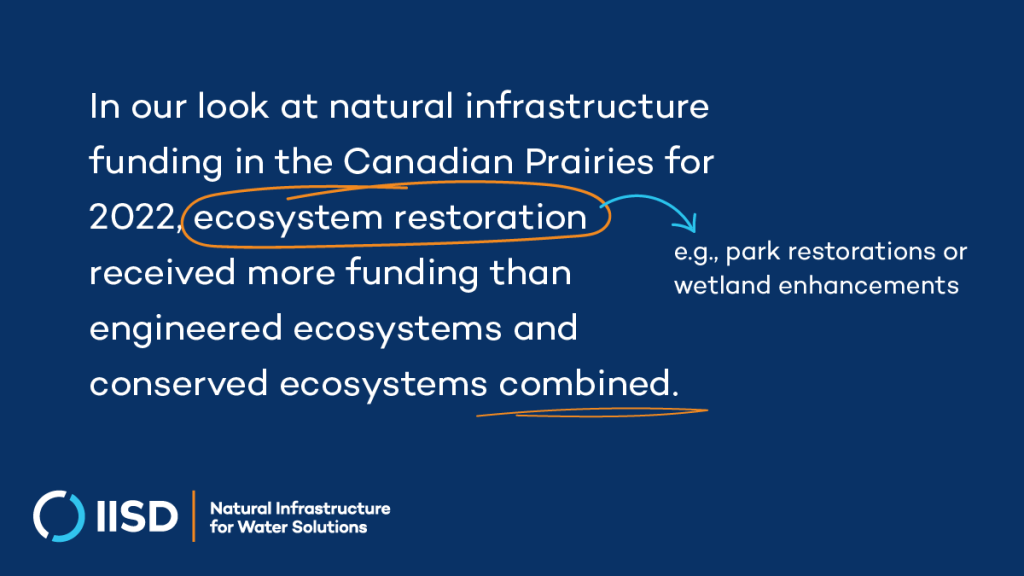
Estimate of Natural Infrastructure Public Grant Funding in Canada and in the Canadian Prairies
Natural infrastructure is a cost-effective solution to simultaneously address Canada's climate, biodiversity, and other environmental, social, and economic priorities. There is an urgent need to increase funding for natural infrastructure in both urban and rural areas. This analysis estimated the amount of public grant funding directed toward natural infrastructure in Canada generally and across the Prairie provinces (Alberta, Saskatchewan, and Manitoba).
-
IISD estimates that nearly CAD 100 million in grants were provided across Alberta, Manitoba, and Saskatchewan to fund natural infrastructure projects in 2022.
-
In our look at natural infrastructure funding in the Canadian Prairies for 2022, ecosystem restoration (e.g., park restorations or wetland enhancements) received more funding than engineered ecosystems and conserved ecosystems combined.
-
Despite the need for more funding of natural infrastructure in the Canadian Prairies, the Natural Infrastructure Fund was the only available funding program specifically dedicated to natural infrastructure in 2022.
Natural infrastructure is a cost-effective solution to meeting Canada’s infrastructure needs that simultaneously addresses our climate, biodiversity, and other environmental, social, and economic priorities. There is an urgent need to design and implement more natural infrastructure projects in both urban and rural environments in Canada and increase funding for natural infrastructure.

This analysis estimated the amount of public grant funding directed toward natural infrastructure in Canada generally and across the Prairie provinces (Alberta, Saskatchewan, and Manitoba). It found the following:
- There is public grant funding available in Canada and the Prairies for ecosystem conservation, restoration, and engineered ecosystems, with one fund—the Natural Infrastructure Fund (NIF)—specially targeting natural infrastructure and hybrid infrastructure to create resilient and sustainable communities.
- 16 funds with a national scope analyzed in this study provide an estimated total of CAD 346.6 million annually toward natural infrastructure in Canada, with an estimated CAD 69.3 million reaching the Prairies.
- In addition, nine provincially funded programs in the Prairies were estimated to contribute CAD 29.1 million annually toward natural infrastructure projects, for a combined total of CAD 98.4 million consisting of both federal and provincial funding.
- Four of the largest funds—the Green Municipal Fund (GMF), the Investing in Canada Infrastructure Program (ICIP) and the ICIP COVID-19 Resilience stream, and the Disaster Mitigation and Adaptation Fund (DMAF)—allocated 0.4%, 0.4%, 13.2%, and 8.7% of their funding toward natural infrastructure respectively, with only a fraction of this funding (between 10% and 30%) directed to the Prairies. However, their impact on natural infrastructure funding in the Prairies remains significant due to their large size.
- From looking at how much funding is directed by these four largest funding programs toward different types of natural infrastructure projects, restored ecosystems represent the largest portion of funding at just over 57%, followed by engineered systems at 41.1%. Conserved ecosystems represented only a small percentage (1.7%) of all natural infrastructure funding, in part because of the lower costs of conservation compared to ecosystem restoration or engineered ecosystems.
- As interest in natural infrastructure grows and more natural infrastructure projects are considered and implemented, increased dedicated public funding streams that ensure natural infrastructure is distributed equitably across communities in need will be essential.
You might also be interested in
Sustainable Asset Valuation of Nature-Based Flood Mitigation Infrastructure in Drakenstein, South Africa
This report analyzes the social, economic, and environmental value of river restoration in Drakenstein Municipality.
State of the Sector: Critical energy transition minerals for India
This report presents a comprehensive strategy for securing a reliable supply of critical energy transition materials (CETMs) essential to India's clean energy and low-carbon technology initiatives.
Reforming Environmentally Harmful Subsidies
This playbook offers a strategic framework for philanthropic organizations to understand, engage, and advance environmentally harmful subsidies reform as a critical avenue for sustainable environmental and economic transformation.
Kigali Shares Lessons on Flood Risk Reduction and Gender Equality With Other Sub-Saharan African Cities
KIGALI, RWANDA—Representatives from 14 organizations and city governments delivering the USD 21 million SUNCASA project will meet in Kigali this week to exchange experiences and insights on advancing nature-based solutions (NbS) for reducing flood and climate risk while improving the lives of women and vulnerable groups.